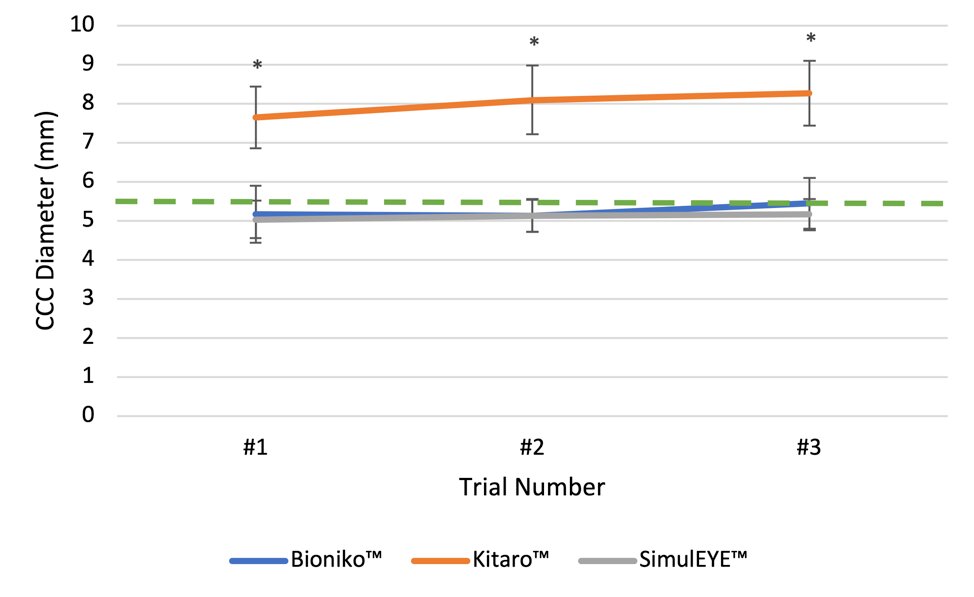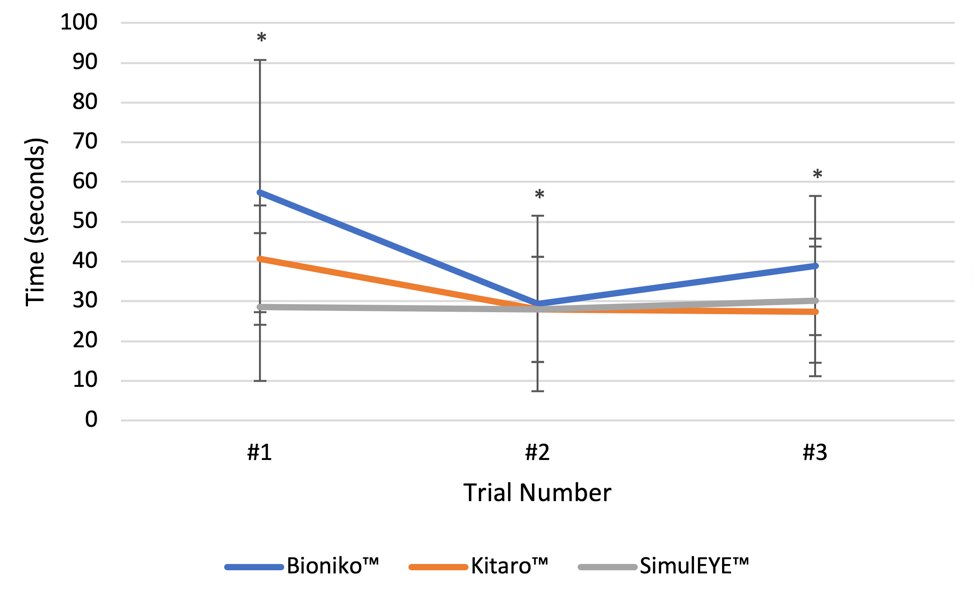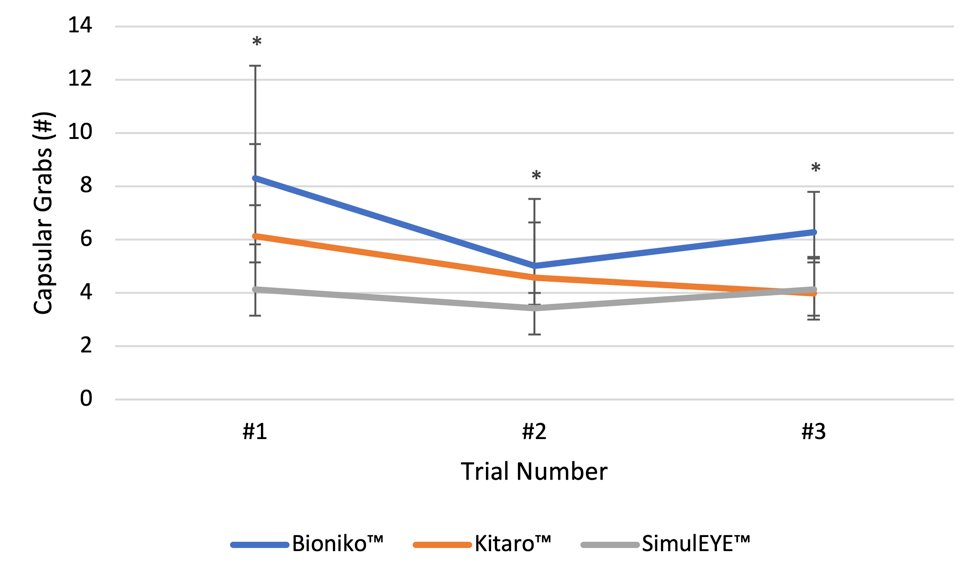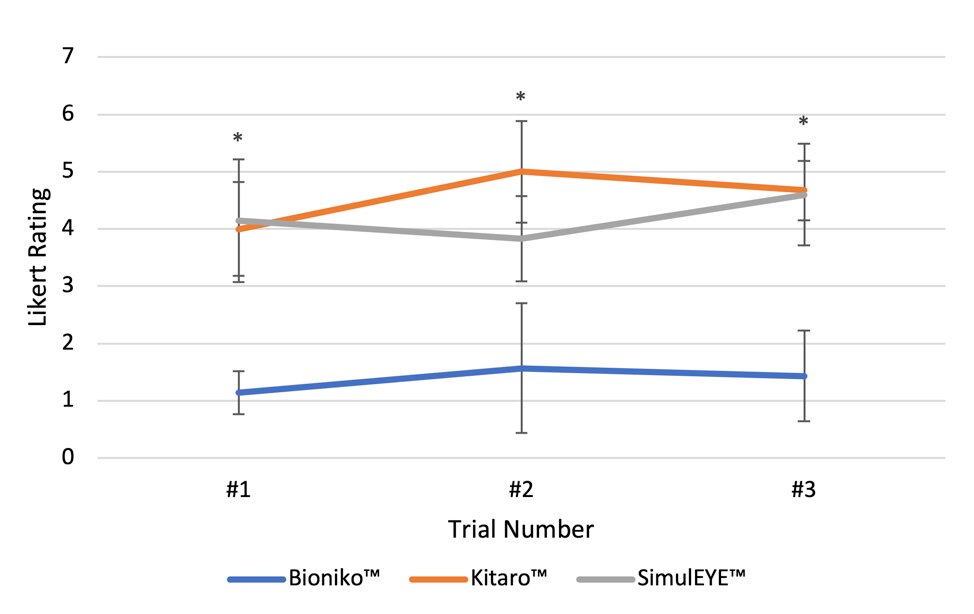Three Cheers for Three CCC Simulators
Capsulorhexis training devices differ in their similarity to actual surgery. Roibeard Ó hÉineacháin reports

Roibeard O’hEineachain
Published: Tuesday, August 31, 2021
 Figure 1: CCC size (mm). Surgeons created the 5.5mm-sized CCC most accurately on Bioniko™ and SimulEYE™. The dashed green line indicates the tasked CCC size of 5.5mm. The CCC on *Kitaro™ was significantly larger than on Bioniko™ and SimulEye™ (p<0.0001) across all trials.
Figure 1: CCC size (mm). Surgeons created the 5.5mm-sized CCC most accurately on Bioniko™ and SimulEYE™. The dashed green line indicates the tasked CCC size of 5.5mm. The CCC on *Kitaro™ was significantly larger than on Bioniko™ and SimulEye™ (p<0.0001) across all trials.
 Figure 2: Duration of CCC (seconds). Surgeons took the longest amount of time to perform the CCC on Bioniko™ compared to Kitaro™ (p=0.02) and SimulEYE™ (p=0.002).
Figure 2: Duration of CCC (seconds). Surgeons took the longest amount of time to perform the CCC on Bioniko™ compared to Kitaro™ (p=0.02) and SimulEYE™ (p=0.002).
 Figure 3: Number of Capsular Grabs: Bioniko™ required a greater number of grabs compared to Kitaro™ p=0.01 and SimulEYE™ (p<0.0001).
Figure 3: Number of Capsular Grabs: Bioniko™ required a greater number of grabs compared to Kitaro™ p=0.01 and SimulEYE™ (p<0.0001).
 Figure 4: Realism of CCC experience based on modified Likert rating (1-7): Surgeons rated the CCC experience on Kitaro™ and SimulEYE™ as more realistic than on Bioniko™ (p<0.0001).
Figure 4: Realism of CCC experience based on modified Likert rating (1-7): Surgeons rated the CCC experience on Kitaro™ and SimulEYE™ as more realistic than on Bioniko™ (p<0.0001).
Tags: cataract and refractive
Latest Articles
Towards a Unified IOL Classification
The new IOL functional classification needs a strong and unified effort from surgeons, societies, and industry.
The 5 Ws of Post-Presbyopic IOL Enhancement
Fine-tuning refractive outcomes to meet patient expectations.
AI Shows Promise for Meibography Grading
Study demonstrates accuracy in detecting abnormalities and subtle changes in meibomian glands.
Are There Differences Between Male and Female Eyes?
TOGA Session panel underlined the need for more studies on gender differences.
Simulating Laser Vision Correction Outcomes
Individualised planning models could reduce ectasia risk and improve outcomes.
Need to Know: Aberrations, Aberrometry, and Aberropia
Understanding the nomenclature and techniques.
When Is It Time to Remove a Phakic IOL?
Close monitoring of endothelial cell loss in phakic IOL patients and timely explantation may avoid surgical complications.
Delivering Uncompromising Cataract Care
Expert panel considers tips and tricks for cataracts and compromised corneas.
Organising for Success
Professional and personal goals drive practice ownership and operational choices.